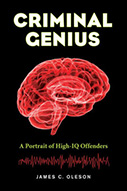CRIMINAL GENIUS: A PORTRAIT OF HIGH-IQ OFFENDERS

Author: James C. Oleson
Publisher: Oakland, CA: University of California Press, 2016. 300p.
Reviewer: David A. Marvelli | October 2017
Many criminologists have written about the relationship between intelligence and crime, often finding an inverse relationship between the two. That is, criminologists have found individuals with a below-average IQ are more likely to commit a criminal offense than higher-IQ individuals. In fact, some have considered IQ among the most significant correlates of crime. However, James Oleson’s Criminal Genius sheds light on the offenses—drawn from self-reports and interviews—committed by high-IQ individuals, a group understudied in the field of criminology.
Using a sample drawn from members of a high IQ society, college students, and prisoners, Criminal Genius demonstrates that high-IQ offenders—defined as individuals with an IQ score of 130 or higher—may commit more offenses than lower IQ individuals. In fact, a novelty of Oleson’s research was the inclusion of participants from a high IQ society, whose members must score 150 or higher on the IQ test for membership, despite several earlier, failed efforts to obtain participation from other high-IQ societies. In addition, Oleson analyzed the study’s participants involvement in 72 offenses. Nonetheless, a limitation of the study was the comparability of offenses committed by high-IQ offenders and the low-IQ offenders—individuals with IQ scores below the average IQ of 100—of previous criminological research since the average IQ score for the control group was approximately 115, an above average IQ.
This study, combined with our knowledge about low-IQ offenders from previous research, makes a compelling argument against the assumption that the relationship between IQ and crime is negative and linear. Oleson suggests the relationship may in fact be curvilinear with higher levels of offending at both extremes of the IQ bell curve. Oleson does demonstrate that individuals at the high end of the spectrum—i.e. those scoring 130 or higher on the IQ test—not only commit crimes but commit a significant number of them. Additionally, Oleson’s study provides some evidence for the “differential detection” hypothesis—i.e. high-IQ offenders may go undetected by law enforcement—since high-IQ offenders were found to be arrested, prosecuted, tried, and sentenced at a lower rate than lower-IQ offenders.
Oleson uses Hirschi’s social bond theory as a theoretical framework to explain his findings of high-IQ offenders, suggesting that high-IQ offenders, especially those with IQ scores of 150 or higher, may have weak social bonds. The interviews conducted for the study suggest, for example, that those with genius-level IQs may feel isolated since they are unable to develop meaningful relationships with individuals with lower IQs. While additional research on high-IQ offenders is needed, Criminal Genius provides a fascinating exploratory study into a very important and interesting topic. It challenges the conventional wisdom about the relationship between crime and IQ levels and makes astute observations about the relationship and areas for future research. I highly recommend this book to all interested in understanding criminal behavior in general and the relationship between crime and intelligence specifically.
David A. Marvelli is a supervisory intelligence analyst for the Federal Bureau of Investigation and an adjunct professor of criminology for the University of Mary Washington. He holds a PhD from Rutgers University.
The views and opinions expressed herein are those of the author and do not necessarily reflect the views of the Federal Bureau of Investigation or the U.S. Government.


